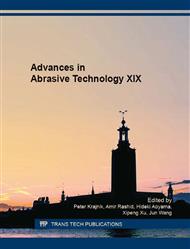[1]
YAO Wang, ZHANG Yumin, HAN Jiecai et al. Fabrication and test of reaction bond silicon carbide for optical applications. Trans. Nonferrous Met. SOC. China. 16 (2006) 409-413.
DOI: 10.1016/s1003-6326(06)60070-8
Google Scholar
[2]
Yonghong Liu, Renjie Ji, Qingyun Li et al. An experimetal investigation for electric discharge milling of SiC ceramics with high electrical resistivity. Journal of Alloys and Compounds 472 (2009) 406–410.
DOI: 10.1016/j.jallcom.2008.04.072
Google Scholar
[3]
P. KOSHY, V.K. JAIN and G.K. LAL. Mechanism of material removal in electrical discharge diamond grinding. Int. J. Mach. Tools Manufact. 36 (1996) 1173-1185.
DOI: 10.1016/0890-6955(95)00103-4
Google Scholar
[4]
S.K. Choudhury, V.K. Jain and M. Cupta. Electrical discharge diamond grinding of high speed steel. Machining Science and Technology. 3 (1999) 91-105.
DOI: 10.1080/10940349908945685
Google Scholar
[5]
K.M. Shu and G.C. Tu. Study of electrical discharge grinding using metal matrix composite electrodes. International Journal of Machine Tools & Manufacture. 43 ( 2003) 845-854.
DOI: 10.1016/s0890-6955(03)00048-8
Google Scholar
[6]
G.K. Singh, V.Y. Yadava and R. Kunar. Multiresponse Optimization of Electro-Discharge Diamond Face Grinding Process Using Robust Design of Experiments. Materials and Manufacturing Process. 25 (2010) 851-856.
DOI: 10.1080/10426910903536758
Google Scholar
[7]
S.S. Agrawal and V. Yadava. Modeling and Prediction of Material Removal Rate and Surface Roughness in Surface- Electrical Discharge Diamond Grinding Process of Metal Matrix Composites. Materials and Manufacturing Processes. 28 (2013) 381-389.
DOI: 10.1080/10426914.2013.763678
Google Scholar
[8]
R.N. Yadav and V. Yadava. Machining performance of slotted-electrical discharge diamond face grinding of Al/SiC/Gr composite. Materials and Manufacturing Processing. 29 (2014) 585-592.
DOI: 10.1080/10426914.2014.892985
Google Scholar
[9]
S.K.S. Yadav and S.K.S. Yadava. Neural network modeling and multi objective optimization of electrical discharge diamond cut-off grinding (EDDCG). International Journal of Abrasive Technology 4 (2011) 346-362.
DOI: 10.1504/ijat.2011.044509
Google Scholar
[10]
Yonghong Liu, Lili Yu, Xiaopeng Li et al. Technology for Electrical Discharge Grinding of No-conductive Engineering Ceramics. Chinese Journal of Mechanical Engineering. 44 (2008) 132-135.
DOI: 10.1049/cp:20060968
Google Scholar
[11]
Sanjeev Kumar and S.K. Choudhury. Prediction of wear and surface roughness in electro-discharge diamond grinding. Journal of Materials Technology. 191 (2007) 206-209.
DOI: 10.1016/j.jmatprotec.2007.03.032
Google Scholar
[12]
S.K. Choudhury, V.K. Jain and M. Cupta. Electrical discharge diamond grinding of high speed steel. Machining Science and Technology. 3 (1999) 91-105.
DOI: 10.1080/10940349908945685
Google Scholar
[13]
P. Koshy, V.K. Jain and G.K. Lal. Mechanism of material removal in electrical discharge diamond grinding. Int. J. Tools Manufact. 36 (1996) 1173-1185.
DOI: 10.1016/0890-6955(95)00103-4
Google Scholar
[14]
Yonghong Liu, Renjie Ji, Yanzhen Zhang, et al, Electrical Discharge Machining of Insulating and Weakly Conductive Engineering Ceramics, Science Press, Beijing, (2015).
Google Scholar
[15]
Ji R, Liu Y, Zhang Y, et al. Effect of machining parameters on surface integrity of silicon carbide ceramic using end electric discharge milling and mechanical grinding hybrid machining[J]. Journal of Mechanical Science & Technology, 27 (2013).
DOI: 10.1007/s12206-012-1215-8
Google Scholar


